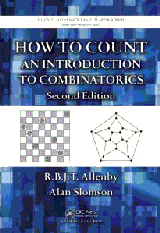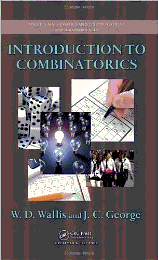How To Count: An Introduction to CombinatoricsR. B. J. T. Allenby |

|
Introduction to CombinatoricsW. D. Wallis |

|
The two books under review are introductory combinatorics texts, also suitable for individual study. I shall refer to them by the combination of the first letters of the authors' last names: AS and WG. Both book are thoughtfully written, contain plenty of material and exercises. Understandably, there is a considerable overlap. Common to the books are the essential topics, like permutations and combinations, the Inclusion-Exclusion principle, generating functions and recurrence relations, graphs and graph algorithms, groups of permutations, counting patterns, Pólya counting, pigeonhole principle and Ramsey theory, and Catalan and Sterling numbers.
AS features chapters on integer partitions, barely touched in WG, and, in general, covers more expansively the common topics, especially, group and Ramsey theories, matching and marriages. WG, on the other hand, devotes separate chapters to the coding theory, Latin squares, balanced incomplete block designs, and applications of linear algebra to combinatorics. AS (p. 228) observes that "Latin squares are interesting and important combinatorial objects, but because of shortage of space we are not able to discuss them in this book." There are briefer, say section-size, differences: rook polynomials, Euclidean Ramsey theory (AS), sum-free sets, exponential generating functions (WG).
In both books exercises come in two categories A and B. The A exercises are supplied with solutions, the B exercises (that in WG are collected in separate sections) are not. WG also offers lists of problems - generally more sophisticated questions - that are accompanied by hints and solutions at the end of the book.
Both books start with extensive Introductions that outline the contents by posing questions and problems that the books deal with subsequently. AS offers short biographical information in footnotes; WG in a separate Appendix. In addition, WG covers some background information (proof techniques, matrices and vectors) in two separate appendices.
WG provides numerous fragments of Mathematica code and this is a nice touch. For example, (pp. 259-260) in problem of determining the number of ways to cover a 2×6 board with nonoverlapping dominos, the authors form a digraph and its adjacency matrix A and then rely on Mathematica's
B = Inverse[IdentityMatrix[6] - x*A];
B[[2,2]]
to obtain the generating function
(1 - 2x2 + x4)/(1- x - 6x2 - x3 + 6x4 + 2x5 - x6)
which they then expand into a power series with
Series[%,{x,0,10}]
and subsequently elucidate the meanings of every coefficient.
For a balance check, AS goes to a considerably greater length introducing elements of group theory as a tool towards Frobenius and Pólya counting theorems.
At this point I would like to confess that the two books were sitting on my desk for a while now. Somehow my first impression was so distressing that I could not see a point in reviewing the books. As the luck would have it, I opened the books the first time on pages with misprints. For AS, it was a confusing swap of sign ">" for "<" on page 296. For WG, it was a section titled "Applications of
Truth be told, in AS, I actually came across only a few more typos and eventually found the text very readable and useful. I can't say the same of WG. The amount of typos there is bewildering. For example, on pages 196-197 there are 3:
- B1A4B3B4B5B6B7 instead of B1B2B3B4B5B6B7
- ainC instead of a∈C, and
- N instead of n.
These were actually a trifle. On page 73, Example 4.3 refers to Example 2.2 (p. 27), while the reference had to be to Example 2.6 (p. 31) The diagram in the latter example is exactly the same as that accompanying Example 4.3, even though the diagram is not quite suitable for the earlier stage.
I truly came to grief with the WG's Index. None of the terms I wanted to check could be found on the pages the Index pointed me to. Only after I decided to record the discrepancies, I realized that a major part of the Index was off by 2 pages. It's not that bad one can say, but not every student may be as savvy or as determined to discover the truth. Further, Index contains the word "Arrangement" that is not defined (far as I can see) anywhere in the book but the pointer is to the definition of "Derangement".
To give one more example, Theorem 13.3 reads, "The balanced bipartite graph B has exactly Per(B(G)) perfect matchings." As a matter of fact the term "balanced bipartite graph" is not found in the Index and, as far as I can judge, is not defined anywhere in the book, at least not where I would expect it to. The same holds for the "Cancellation law" entry.
Thus for a long time I was at a loss whether to write a review or to let time pass. Then somebody tweetted me a review (by John Trimble) of Writing With Style: Conversations on the Art of Writing, a book by James M. Lang. The review is full of praise, in particular from the book's current editor Brad Potthoff:
He brings out the best in his editors and asks as much of them as he does of himself. As such, working with John is a joyous challenge and one of the highlights of my career.
This note gave me a point of reference and an impulse to pull myself together. Whether or not this is due to the authors' failure to engage the editors at CRC, but the fact is that the latter did a lousy job editing the books, crucially so for WG.
How To Count: An Introduction to Combinatorics, by R. B. J. T. Allenby, Alan Slomson. Chapman and Hall/CRC; 2 edition (August 12, 2010). Hardcover, 444 pp, $79.95
Introduction to Combinatorics, by W. D. Wallis, J. George. Chapman and Hall/CRC; 1 edition (September 7, 2010). Hardcover, 397 pp, $79.95
|Up| |Contact| |Front page| |Contents|
Copyright © 1996-2018 Alexander Bogomolny71548449
